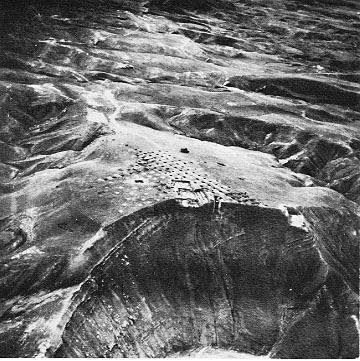Reading in this book by H.V.Morton I was struck by something he said when on an ancient roadway. He was discussing a building erected generations before to protect traders as they reached the half way point on the journey. It had been standing there in one form or another there about three thousand years, possibly following on a resting place going back much, much further. This got me thinking about something those colonials in the Americas sometimes say regarding old UK buildings being 'ancient,' and 'historical.' Many Americans touring the free world do find the age off buildings fascinating and it brought to mind Soub's picture of a building in Texas dating from I think 1848. This wooden structure, reminiscent of a 'cowboy' TV set, was classed as the 'Oldest building in town.' Now 1848 is not that far back, my Grandfather was born a mere three years earlier in 1845 and I am only 25 so it is only two generations, yet in the USA the early 1800's are ancient history. Of course man has been living on that land for thousands of years but the mind forgets this and concentrates only on present culture when considering the past. Our view is often limited by ourselves.
History is seen in the buildings. Edinburgh, towering above the world was built of solid stone structures reaching for the sky ten or twelve stories high. This reflected the available materials, the numbers crowding inside the walls and the need for walls to defend against the nasty English invaders. The 'closes' contain housing reaching back several hundred years each with its own history, each worthy of a blog all by themselves. Digging back further prehistoric man lived in several places around the city, both on Castle Rock and Arthur's Seat and in the Pentland Hills nearby.
In the part of paradise in which I dwell houses arose from the wood that covered the land. Made of wood and plaster with only castles made from stone and the churches flint and rubble, contained in a form of 'clinker,' often containing Roman brickwork. The latter showing how happy many Britons were to accept Roman standards. Many building in this small town go back to well before the 1800, one in the High Street has a pillar dated to 1395 I was told. Dating trees is an interesting insight into the age of buildings. Quite a few began their life in the early Medieval period and have been transformed according to contemporary needs and still serve their purpose today. The stairs creak a wee bit mind! People were known to be farming in this district at least four thousand years ago, some of their leftovers have been found. Before them as the Ice Age receded man trekked this land from the south of Cornwall across what became the North Sea to northern Germany following the herds hunting and gathering. No buildings were left but signs of habitation are abundant. The melting ice gave us the North Sea and fishermen still dredge up mammoth Tusks and the like daily.
While such nomads dragged their weary way in the cold north the peoples of Mesopotamia were already beginning to farm, gathering cattle, sheep and goats, and no doubt dogs and cats also, to produce a more settled life. The cities of Ur and Uruk had something like 60,000 citizens five thousand years ago. Their mud brick buildings lie in the south of what is now Iraq. This seems ancient to us who consider the Greek and Roman period as far distant yet Mesopotamia is a rich cultural heritage ignored for the most part and contains, so they say, our beginnings. Further back settled life arose Jarmo at least 7000 years before Christ and hunter gatherers walked for millennia before that. Man spread out quickly over the earth and similar finds occur in China, India and South America going back thousands of years.
It makes the history of this wee town appear quite recent. It also makes me feel quite young.
.


